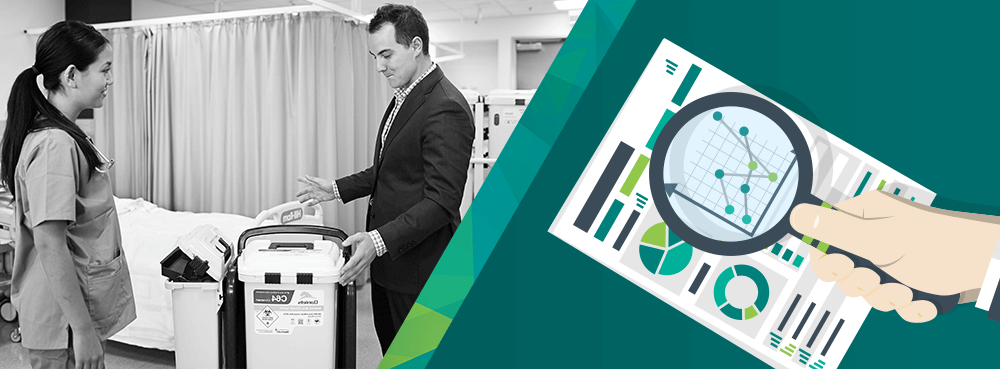How Waste Audits Benefit Healthcare Waste Segregation

“We do not accept that our responsibility stops at the back dock of a hospital picking up waste. As guardians of the biohazardous waste journey within healthcare facilities, it is our clear responsibility to ensure that our expertize, solutions, and training directly impacts what ends up at the hospital loading dock.”
A strong pillar of Daniels Health is our commitment to environmental outcomes; this is outworked through our reusable sharps and medical waste containment systems – eliminating thousands of tons of plastic and cardboard from landfills each year and dramatically reducing the CO2 output associated with manufacturing, our sustainable washing and treatment methodologies, and, first and foremost, the impact we have in reducing and segregating healthcare waste at source within the facilities we work with.
How does the Daniels audit process work?
Once a biohazardous waste stream has been identified, the containers in a designated ward or area of the hospital will be “tagged” so they are easily recognized when they arrive at the Daniels plant. Each container is tracked to a location by barcode, and containers are weighed upon disembarkation. The team responsible for conducting waste audits are required to wear appropriate PPE and, using a designated sorting table – contents are analyzed and photographed to give a true indication of proper and improper segregation by waste stream. During this process, trend-like exceptions are noted against each hospital location for further corrective action.
“The waste audit process is a collaboration between Daniels and our customer. If we do not partner and work together, we will not drive the most sustainable or compliant results in medical or hazardous waste disposal.”
Evan August
How waste audits can drive greater healthcare waste segregation potential:
Healthcare Waste Segregation audits are meaningless unless some corrective action is implemented to prevent recurrence of incorrect segregation behaviors. As part of our KPI review with the hospitals we partner with, Daniels Health compiles a full visual analysis of the audit results to drive awareness and action from a facility leadership level. Furthermore, the results of the audit provide insight into waste segregation behavior indicators – poor container placement, or the absence of alternate waste-stream receptacles; Based on locations audited, the Daniels team conducts additional training to educate users on proper segregation and, particularly, correct hazardous waste disposal to minimize compliance risks.
What are the costs of not identifying correctly segregated healthcare waste?
Incorrectly segregated waste, particularly heavily regulated waste streams such as infectious, biohazardous, chemotherapy, sharps and hazardous pharmaceutical waste, can risk heavy fines to the waste generator for non-compliance, place healthcare workers unnecessarily at risk, increase environmental burden, and escalate operational risks and treatment costs. But not only this… there is also a cost to over-categorization of general solid waste or other forms of non-biohazardous waste.
Imagine this…. A medical waste bin filled with some empty candy boxes, McDonalds wrappers, bunches of browning flowers, and the odd soda can. This may seem like an unlikely scenario, but let us assure you – it is more common than you would think! The cost to your facility of poorly segregated, over-categorized waste is huge – medical waste or hazardous waste is much more expensive to dispose of than solid waste, so you will be left paying a premium to treat a non-infectious soda can!
What about safety, compliance or environmental risks?
Incorrectly disposed waste poses an immediate threat to healthcare workers or waste handlers (such as environmental services, laundry or cleaners) if there are infectious or sharp objects deposited. For example, sharps incorrectly disposed into a red bag, puts not only hospital staff at risk, but also puts our own Daniels staff at risk.
From a regulatory and environmental perspective – incorrectly segregated biohazardous waste can have significant implications on human safety, compliance and responsible landfill. For example, hazardous materials, which must be handled separately and generally incinerated, can compromise treatment effectiveness if they are not clearly defined. If hazardous materials are mixed in with a regular waste stream and autoclaved – there is a high probability that firstly the treatment would be ineffective, and secondly posing danger in the autoclave process. In such situations, the waste generator is, by law, in breach of their waste disposal responsibilities and could incur a violation for improper handling and fined thousands of dollars.
We help our customers to do their best
With over 30 years experience in healthcare, we understand the pressures healthcare workers are under to deliver patient outcomes in a fast paced environment… correctly segregating healthcare waste is not always front of mind in the hierarchy of importance within a hospital! Correct medical waste containers are sometimes substituted for ‘conveniently located’ general waste containers, so an essential part of our job is to ensure that the right container is located in the right location so we mitigate the “too hard to find” complaints.
“Ongoing training is an essential part of Daniels’ waste review process. After a few months bad habits set in, and the normal cycle of new staff coming in demands a reimplementation of segregation disciplines”
Your brand is worth protecting
Healthcare Waste Segregation audits are an essential part of our commitment to protect your brand. Under US law, all waste generators have cradle-to-grave responsibility for biohazardous waste generation. What does this mean? It means that from the moment medical waste or hazardous waste is discarded in a bin within your facility to the moment it is treated at a partner processing plant – you are responsible for it, not your waste management partner. Through audits, clinical containment systems, ongoing training and expert waste segregation processes – we partner with you to minimize your risk exposure and ensure your people, your brand and the environment are adequately protected. Learn more about our healthcare waste optimization approach here.
Let's Talk!
Your time is valuable, and we don’t want to play hard to get. You can either phone us directly on the details listed on our contact page, or feel free to fill out this short form and one of our team members will get back to you as quickly as possible.
